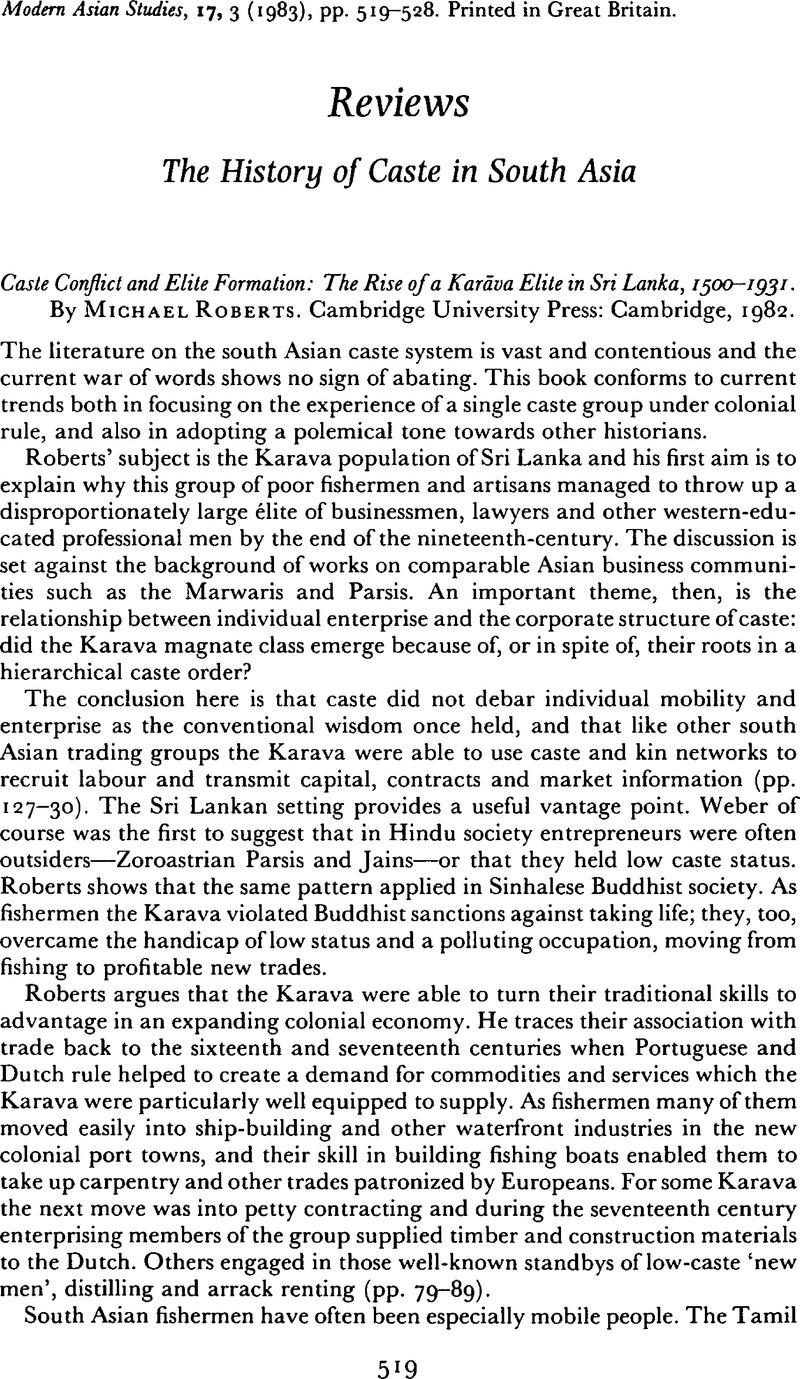Published online by Cambridge University Press: 28 November 2008

1 See e.g. my article, ‘A Christian Caste in Hindu Society: Religious Leadership and Social Conflict among the Paravas of Southern Tamilnadu’, in Modern Asian Studies, 15, 2 (1981), pp. 177–201Google Scholar; and Timberg, Thomas A., The Marwaris—From Traders to Industrialists (Delhi, 1977).Google Scholar
2 A Caste in a Changing World. The Chitrapur Saraswat Brahmans, 1700–1935 (Berkeley, 1977).Google Scholar
3 ‘The South Indian Temple: Authority, Honour and Redistribution’, in Contributions to Indian Sociology (NS) 10, 2 (1976), pp. 187–211.CrossRefGoogle Scholar
4 Unlike some authors who have described low-caste mobility in India, Roberts does not claim that the Karava were trying to break out of the caste system itself, but were attempting to escape its ‘disabilities’ by adopting higher caste customs and privileges (p. 140). This is part of a more general argument that the Karava and other migrant castes were only partially ‘integrated’ into Sinhalese Buddhist society during the colonial period. He argues that they were undergoing ‘acculturation and integration’ into the Sinhalese social structure during the nineteenth and early twentieth centuries and that their effort to emulate the Goyigamas’ lifestyle was one of the signs of this process. One problem here is that if the Karava were an exceptional group, outsiders who were not fully absorbed into the Sinhalese social order even by the nineteenth century, then it is hard to see them as a general case which can be applied to a discussion of caste structure and ideology among mainstream Hindu castes in India.
5 An Untouchable Community in South India. Structure and Consensus (Princeton, New Jersey, 1979).Google Scholar
6 See Moffatt's discussion of works by Gough, Kathleen, Joan Mencher and Gerald Berreman (pp. 9–24).Google Scholar
7 This is the attempt by low castes to elevate their status by emulating the lifestyle of their caste superiors. See Srinivas, , Caste in Modern India and Other Essays (London, 1970).Google Scholar
8 Hardgrave, Robert L. Jr., The Nadars of Tamilnad. The Political Culture of a Community in Change (Berkeley, 1969)Google Scholar; Jeffrey, Robin, The Decline of Nayor Dominance: Society and Politics in Travancore, 1847–1908 (London, 1976).Google Scholar
9 See, in particular, Washbrook, D. A., ‘The Development of Caste Organisation in South India 1880 to 1925’, in Baker, C. J. and Washbrook, D. A. (eds), South India: Political Institutions and Political Change 1880–1940 (Delhi, 1975), pp. 150–203.CrossRefGoogle Scholar
10 Review by C. J. Baker of Jeffrey, The Decline of Nayar Dominance in Modern Asian Studies 12, 2 (1977), pp. 306–9Google Scholar; and review by D. A. Washbrook of Hardgrave, The Nadars of Tamilnad in Modern Asian Studies 5, 3 (1971), pp. 278–83.CrossRefGoogle Scholar
11 Washbrook, , ‘The Development of Caste Organisation’, p. 189.Google Scholar
12 The traveller Francis Buchanan encountered ‘Nayar’ potters, tailors and palanquin bearers. See A Journey from Madras through the Countries of Mysore, Canara and Malabar (Madras, 1807), vol. II, pp. 408–9Google Scholar. And the assimilation of ritually polluting Tamils into the Nayar caste category is described by Iyer, L. K. Anantha Krishna in The Cochin Tribes and Castes (Madras, 1912), vol. II, p. 18.Google Scholar